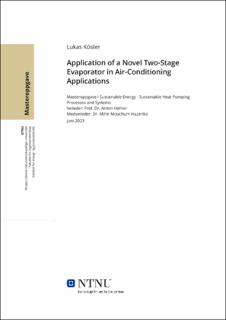| dc.contributor.advisor | Hafner, Armin | |
| dc.contributor.advisor | Hazarika, Mihir Mouchum | |
| dc.contributor.author | Köster, Lukas | |
| dc.date.accessioned | 2023-10-03T17:22:49Z | |
| dc.date.available | 2023-10-03T17:22:49Z | |
| dc.date.issued | 2023 | |
| dc.identifier | no.ntnu:inspera:142433533:55503854 | |
| dc.identifier.uri | https://hdl.handle.net/11250/3093917 | |
| dc.description.abstract | Det foreliggende arbeidet undersøker anvendelsen av en ny totrinns fordamper i kombinasjon med et avansert hydronisk delsystem for å dekke luftkondisjoneringsbehov. Den foreslåtte systemarkitekturen består av en totrinns fordamperkonfigurasjon implementert i en \coo varmepumpe, som er koblet med et påfølgende hydronisk system til luftbehandlingsenheten og dermed til luftvolumet. Det vannbårne systemet utnytter sensitiv og latent termisk energilagring ved hjelp av kaldtvannslagring og istanker. På grunn av den hydroniske systemarkitekturen kan det hydroniske systemet operere i 15 forskjellige driftsmoduser, som styres av en tilpasset regelbasert optimal kontrollstrategi. En modell av systemet er bygget i modelica. Dynamiske 24-timers simuleringer utføres for å bestemme systemets oppførsel og ytelsesegenskaper. Basert på eksemplariske data og komponentstørrelser kunne en lastforskyvning på 65 \% av den totale toppbelastningen til lavlastperioder oppnås. Videre oppnådde systemet å begrense toppbelastningen på varmepumpesystemet og gir et grunnlag for konstante driftsforhold for varmepumpen i høylastperioden. Systemoppsettet har vist seg å gi stor fleksibilitet for å tilpasse seg de spesifikke bruksområdene og driftsbetingelsene. \\
I tillegg er det utført innledende eksperimentelle tester av totrinns fordamperkonfigurasjonen. | |
| dc.description.abstract | The present work investigates the application of a novel two-stage evaporator in combination with an advanced hydronic sub-system to cover air conditioning demands. The proposed system architecture consists of the two-stage evaporator configuration implemented within a \coo heat pump, which is connected by a subsequent hydronic system to the air handling unit and thereby to the air volume. The hydronic system utilizes sensible and latent thermal energy storage by cold water storage and ice tanks. Due to the hydronic system architecture, the hydronic system can operate in 15 different operation modes, which are controlled by an adapted rule-based optimal control strategy. A model of the system is built in Modelica. Dynamic 24-\unit{\hour } simulations are carried out to determine the system behaviour and performance characteristics. Based on exemplary data and component sizes, a load-shifting of 65\% of the total on-peak load to off-peak periods could be achieved. Furthermore, the system achieved to limit the peak demand on the heat pump system and provides a basis for constant operating conditions of the heat pump during the on-peak period. The system setup has shown to provide great flexibility to adapt to specific applications and operating conditions. Additionally, preliminary experimental tests of the two-stage evaporator configuration are carried out. | |
| dc.language | eng | |
| dc.publisher | NTNU | |
| dc.title | Application of a Novel Two-Stage Evaporator in Air-Conditioning Applications | |
| dc.type | Master thesis | |
